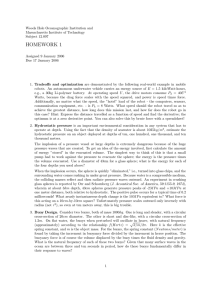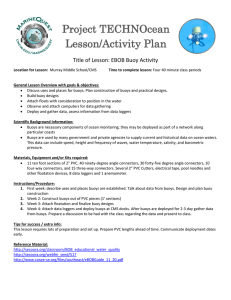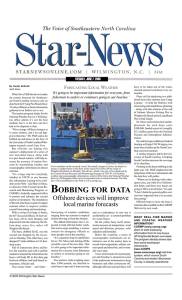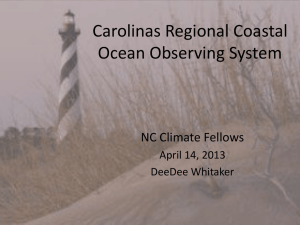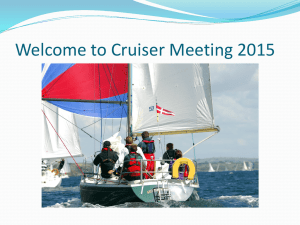Document 12009915
advertisement
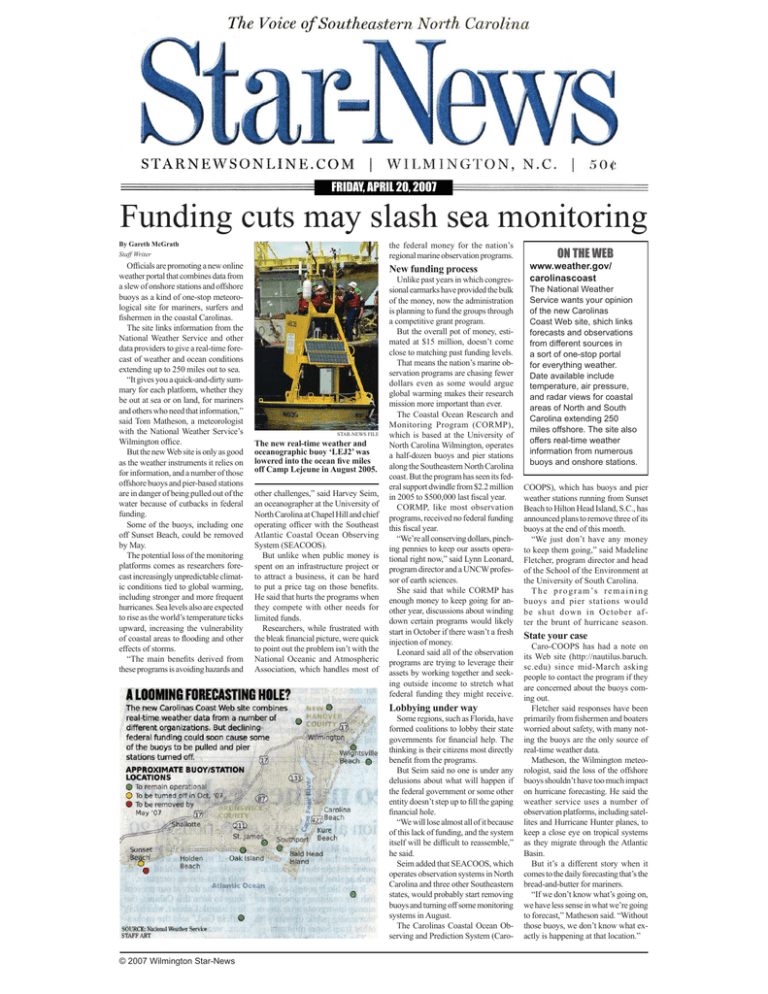
FRIDAY, APRIL 20, 2007 Funding cuts may slash sea monitoring By Gareth McGrath Staff Writer the federal money for the nation’s regional marine observation programs. Officials are promoting a new online weather portal that combines data from a slew of onshore stations and offshore buoys as a kind of one-stop meteorological site for mariners, surfers and fishermen in the coastal Carolinas. The site links information from the National Weather Service and other data providers to give a real-time forecast of weather and ocean conditions extending up to 250 miles out to sea. “It gives you a quick-and-dirty summary for each platform, whether they be out at sea or on land, for mariners and others who need that information,” said Tom Matheson, a meteorologist with the National Weather Service’s Wilmington office. But the new Web site is only as good as the weather instruments it relies on for information, and a number of those offshore buoys and pier-based stations are in danger of being pulled out of the water because of cutbacks in federal funding. Some of the buoys, including one off Sunset Beach, could be removed by May. The potential loss of the monitoring platforms comes as researchers forecast increasingly unpredictable climatic conditions tied to global warming, including stronger and more frequent hurricanes. Sea levels also are expected to rise as the world’s temperature ticks upward, increasing the vulnerability of coastal areas to flooding and other effects of storms. “The main benefits derived from these programs is avoiding hazards and New funding process STAR-NEWS FILE The new real-time weather and oceanographic buoy ‘LEJ2’ was lowered into the ocean five miles off Camp Lejeune in August 2005. other challenges,” said Harvey Seim, an oceanographer at the University of North Carolina at Chapel Hill and chief operating officer with the Southeast Atlantic Coastal Ocean Observing System (SEACOOS). But unlike when public money is spent on an infrastructure project or to attract a business, it can be hard to put a price tag on those benefits. He said that hurts the programs when they compete with other needs for limited funds. Researchers, while frustrated with the bleak financial picture, were quick to point out the problem isn’t with the National Oceanic and Atmospheric Association, which handles most of Unlike past years in which congressional earmarks have provided the bulk of the money, now the administration is planning to fund the groups through a competitive grant program. But the overall pot of money, estimated at $15 million, doesn’t come close to matching past funding levels. That means the nation’s marine observation programs are chasing fewer dollars even as some would argue global warming makes their research mission more important than ever. The Coastal Ocean Research and Monitoring Program (CORMP), which is based at the University of North Carolina Wilmington, operates a half-dozen buoys and pier stations along the Southeastern North Carolina coast. But the program has seen its federal support dwindle from $2.2 million in 2005 to $500,000 last fiscal year. CORMP, like most observation programs, received no federal funding this fiscal year. “We’re all conserving dollars, pinching pennies to keep our assets operational right now,” said Lynn Leonard, program director and a UNCW professor of earth sciences. She said that while CORMP has enough money to keep going for another year, discussions about winding down certain programs would likely start in October if there wasn’t a fresh injection of money. Leonard said all of the observation programs are trying to leverage their assets by working together and seeking outside income to stretch what federal funding they might receive. Lobbying under way Some regions, such as Florida, have formed coalitions to lobby their state governments for financial help. The thinking is their citizens most directly benefit from the programs. But Seim said no one is under any delusions about what will happen if the federal government or some other entity doesn’t step up to fill the gaping financial hole. “We will lose almost all of it because of this lack of funding, and the system itself will be difficult to reassemble,” he said. Seim added that SEACOOS, which operates observation systems in North Carolina and three other Southeastern states, would probably start removing buoys and turning off some monitoring systems in August. The Carolinas Coastal Ocean Observing and Prediction System (Caro© 2007 Wilmington Star-News ON THE WEB www.weather.gov/ carolinascoast The National Weather Service wants your opinion of the new Carolinas Coast Web site, shich links forecasts and observations from different sources in a sort of one-stop portal for everything weather. Date available include temperature, air pressure, and radar views for coastal areas of North and South Carolina extending 250 miles offshore. The site also offers real-time weather information from numerous buoys and onshore stations. COOPS), which has buoys and pier weather stations running from Sunset Beach to Hilton Head Island, S.C., has announced plans to remove three of its buoys at the end of this month. “We just don’t have any money to keep them going,” said Madeline Fletcher, program director and head of the School of the Environment at the University of South Carolina. T h e p r o g r a m ’s r e m a i n i n g buoys and pier stations would be shut down in October after the brunt of hurricane season. State your case Caro-COOPS has had a note on its Web site (http://nautilus.baruch. sc.edu) since mid-March asking people to contact the program if they are concerned about the buoys coming out. Fletcher said responses have been primarily from fishermen and boaters worried about safety, with many noting the buoys are the only source of real-time weather data. Matheson, the Wilmington meteorologist, said the loss of the offshore buoys shouldn’t have too much impact on hurricane forecasting. He said the weather service uses a number of observation platforms, including satellites and Hurricane Hunter planes, to keep a close eye on tropical systems as they migrate through the Atlantic Basin. But it’s a different story when it comes to the daily forecasting that’s the bread-and-butter for mariners. “If we don’t know what’s going on, we have less sense in what we’re going to forecast,” Matheson said. “Without those buoys, we don’t know what exactly is happening at that location.”
